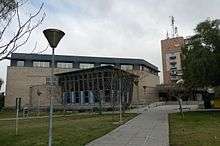National University of Cuyo
| Universidad Nacional de Cuyo | |
|
Seal of the National University of Cuyo | |
| Motto | In spiritus remigio vita (Latin) |
|---|---|
Motto in English | Life is in the wingbeat of the spirit |
| Type | Public |
| Established | 1939 |
| Rector | Ing. Agr. Daniel Pizzi |
| Vice-rector | Ing. Jorge Barón |
Academic staff | 4,071 |
| Students | 44,160 (2016) |
| Location |
Mendoza, Mendoza Province, Argentina 32°52′50″S 68°52′42″W / 32.880650°S 68.878306°WCoordinates: 32°52′50″S 68°52′42″W / 32.880650°S 68.878306°W |
| Colors |
Green, white and blue |
| Website |
www |
The National University of Cuyo (Spanish: Universidad Nacional de Cuyo, UNCuyo) is the largest center of higher education in the province of Mendoza, Argentina.
As of 2005, the university had 12 academic schools in the city of Mendoza and a delegation in the city of San Rafael (province of Mendoza), in addition to the Balseiro Institute, which is the most developed institute of Physics research in Argentina, located in the city of San Carlos de Bariloche (province of Río Negro). It includes the University Technological Institute which offers technical education in four other cities in Mendoza province. Moreover, UNCuyo is also devoted to improving education due to having 7 other buildings working as High Schools:
- C.U.C. (Colegio Universitario Central "Gral. Jose de San Martin")
- Escuela de Comercio Martín Zapata
- Liceo Agrícola Domingo Faustino Sarmiento
- Escuela del Magisterio
- Escuela de Agricultura
- D.A.D (Departamento de Aplicación Docente)
- Escuela Carmen Vera Arenas

History
The UNCuyo was established on March 21, 1939 by the presidential decree 26971. The university was established to offer tertiary education provision in the region of Cuyo (the provinces of Mendoza, San Juan and San Luis). At its foundation the university was composed of some existing higher education colleges, and new ones were incorporated. Regional affiliations were established in Human Sciences, Medicine, Agronomy and Economics in Mendoza, Engineering and Architecture in San Juan, and Natural Sciences in San Luis. These links remained in place until 1973. That year the National University of San Juan and the National University of San Luis were established from the adjunct faculties of the National University of Cuyo already in these regions. Thereafter, the National University of Cuyo concentrated itself in Mendoza, in addition to a campus in Río Negro Province: the Balseiro Institute.

Schools
School of Engineering

- Industrial Engineering
- Civil Engineering
- Petroleum Engineering
- Mechatronics Engineering
- Architecture (since 2012)[1]
Graduate
- PhD in Engineering
- Master in Logistics and Supply Chain Management
- Master in Environmental Engineering
- Specialization in Environmmental Engineering
- Master in Energy
- Master in Structural Engineering
- Diploma in Administration and Direction of Projects
- Diploma in Administration and Control of Buildings
- Diploma in Management of Good Quality
- Diploma in Management of Innovations and Technologies of Information and Communication.
Balseiro Institute (San Carlos de Bariloche, Río Negro)
- Mechanical Engineering
- Physics
- Nuclear Engineering
Graduate
- PhD in Physics
- PhD in Nuclear Engineering
- PhD in Engineering Sciences
- Master of Physic Sciences
- Master of Medical Physics
- Master of engineering.
- Specialization Nuclear Energy Technological Applications
School of Arts and Plastic Design

- Art
- History of Art
- Sculpture
- Graphic design
- Industrial design
- Scenic design
- Voice
- Musicology
- Choral Direction
- Instruments
- Dramatic Arts
- Theatre Production
School of Economic Sciences

- Accountancy
- Business Administration
- Economics
Graduate
- MBA
- MBA - Executive
- Master in Management of Agroindustrial Business
- Master in Management of H.R. (Human Resources)
- Specialization in Costs and Management of Business
- Specialization in Technnology Management
- Specialization in Labour Unions
- Course of Merging, Union and Scission of Enterprises.
- Course of Financial Strategy
- Course of Foreign Trade
- Course of Accountings
There are many others. For further information please visit: http://www.fce.uncu.edu.ar/paginas/index/cursos
School of Exact and Natural Sciences

- Biology
- Mathematics
- Physics
- Chemistry
School of Medicine

- Medicine
- Nursing
- Anaesthesiology
- Clinical Pathology
- Surgery
- Haematology
- Radiology
School of Social and Political Sciences

- Political Science and Public Administration
- Sociology
- Social Work
- Communication
School of Law
- Law
Graduate
- PhD in Law
- Specialization in Law of Damages
- Master of Administrative Law
- Specialization and Master of Magistrature and Steps of the Judicial process
- Specialization in Labour Law
- Course of Family Law
- Course of History for the Bicentennial
School of Humanities

- Philosophy
- Philology
- History
- Geography
- French
- English
- Italian
- Education Sciences
School of Dentistry

- Dentistry
- Dental Hygiene
Elementary and Special-Needs Education
- Primary Education
- Education for the deaf
- Speech Therapy
- Education for the blind
School of Agricultural Sciences
- Agricultural Engineering
- Bromatology
Applied Sciences (San Rafael, Mendoza)
- Food Engineering
- Chemical Engineering
- Chemistry
- Chemical Analysis
- Industrial Chemistry
- Bromatology
Recent research
In recent research conducted by UNCuyo's students it was discovered how methods of cutting and preparing food can affect how many nutrients are retained in a meal.[2] Notably they found that the thiosulfinates (that inhibit platelet aggregation and microparticle shedding) found in garlic and onions do not form until crushing or cutting. The research also demonstrated that steaming instead boiling is preferable as vegetables retain more of their water-soluble vitamins.
See also
References
- ↑ https://fing.uncu.edu.ar/academico/grado/arquitectura
- ↑ Coax flavor, nutrition from produce with proper care, handling
External links
| Wikimedia Commons has media related to Universidad Nacional de Cuyo. |

